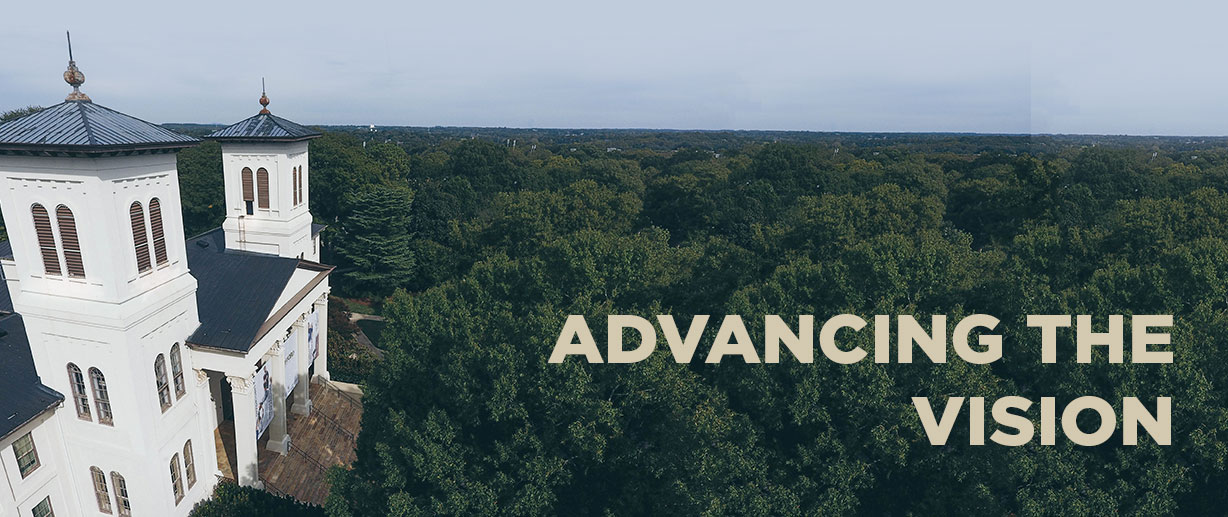A vision of academic excellence, exemplary student experience, strategic enrollment and retention, a strong campus community and a sustainable physical campus — Wofford’s strategic vision, as conceptualized and written by students, faculty, staff and alumni and unanimously approved by the Board of Trustees in October 2014, embraces “one-on-one learning, integrates residential and extracurricular into the learning experience and celebrates diversity, financial and environmental sustainability, and creativity and community involvement.”
In the years following its approval, Wofford’s strategic vision has gone from thought to reality, with concrete action taken within every recommendation. Coordinated work by the faculty on general education reform, establishment and thorough use of the Rosalind Sallenger Richardson Center for the Arts, execution of a strategic enrollment plan and comprehensive capital campaign, enhancement of diversity and inclusion initiatives, deliberate work toward enriching shared faculty governance, steps toward improving sustainability and green initiatives and construction of the Stewart H. Johnson Greek Village and the Jerry Richardson Indoor Stadium are some of the many steps taken by Terriers over the past five years.
“Now is the time to reassess and again look to the future,” says President Nayef Samhat. “How can we transform and extend what we have done to make our college even stronger, more competitive and able to withstand external pressures impacting other major liberal arts institutions across the nation?”
Those external pressures are real. Declines in enrollment, demographic shifts, increased regulations and an inability to increase net revenue have forced many closures or consolidations of colleges across the country. The situation at Wofford remains positive with an increase in applications by nearly 60 percent. This position of strength and positive momentum makes now the ideal time to build.
“Wofford is in a good position; applications continue to rise, and the endowment is strong. We advance as thought leaders in a premier tier of national liberal arts colleges. Our place in that top decile means we must provide the best academic offerings and the best facilities to attract the best students,” says Samhat.
What does the five-year plan look like?
Components of the five-year plan include an increase of approximately 125 students over the next five years and an enhancement of academic and residential facilities, including:
Construction of Jerome Johnson Richardson Hall in the heart of campus
Named in honor of the donor for the project, the 150-bed residence hall will be located where Andrews Field House now sits and will overlook the college’s Russell C. King Field at Switzer Stadium, where the Terriers play baseball, and Snyder Field, the college’s soccer field. The residence hall will house a variety of student activities facilities on its main floor and will provide beautiful living, fellowship and study areas for students. Jerome Johnson Richardson Hall, opening fall 2020, will be the first student housing built on Wofford’s campus since 2011.
Replacement of Black Science Annex with a new, state-of-the-art environmental studies building
Enhancement of the college’s environmental studies program in order to build upon Wofford’s strong programs in the sciences, social sciences and humanities
Renovation of the Sandor Teszler Library
The 2014 Strategic Vision called for the creation of an academic commons, focusing on redesigning the library as the “connecting point for student scholarship, learning resources
Renovation of Burwell Dining Hall
AVI Foodsystems, Wofford’s culinary services partner, is excited to invest in a total renovation of Burwell Dining Hall that will focus on the AVI vision of “Fresh Food Forward.”
“We look forward to bringing specialized food areas into the dining hall so we may prepare food in full view of our student guests,” says Walter Miller, district manager of AVI Fresh. “Healthy, fresh and sustainable food options are more than a model for us — it’s a way of life for the AVI team.” The renovation of Burwell will include a modern glass atrium, elevator, culinary options on both floors and an increase of about 150 seats. The Burwell renovation is expected to be completed by winter 2021.
By Annie S. Mitchell
